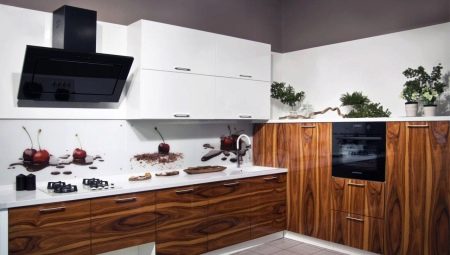Today, veneered facades in the kitchen are becoming increasingly popular. This is not surprising, because they look like real wood, smell like wood, and even by touch do not differ from wood. At the same time, the cost of the panels is very affordable and affordable for most of our compatriots.
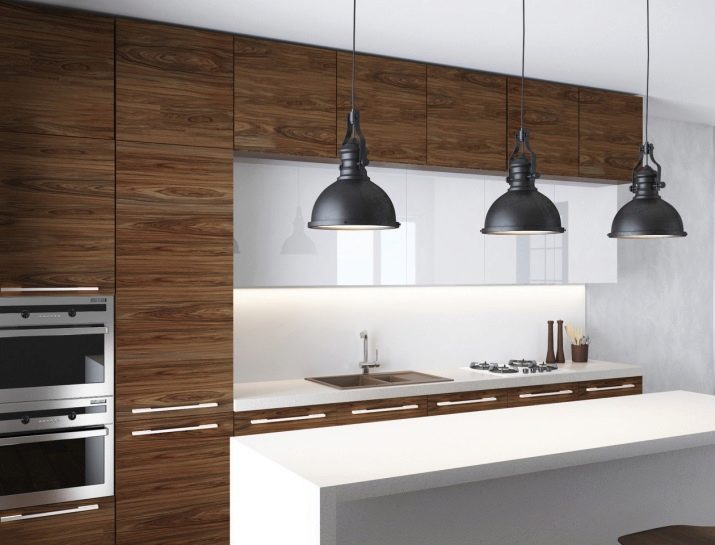
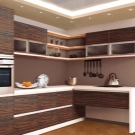

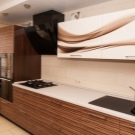
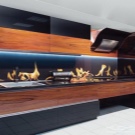
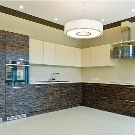
Advantages and disadvantages
The veneer is an MDF board with the thinnest coating, not exceeding a thickness of 0.6-1 mm. Technically, the plates consist of two layers:
- MDF - small wood shavings impregnated with lignin or paraffin and pressed into a solid monolithic panel;
- veneer - a thin section of elite wood glued to MDF and coated with enamel or varnish.
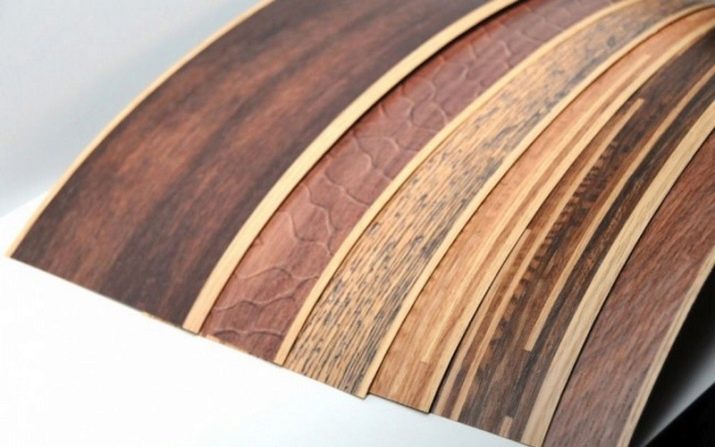
Like any other material, veneer has its own advantages and disadvantages.
The advantages include the following characteristics:
- unlike wood mass, veneer is less prone to cracking and warping in a humid environment - this significantly prolongs the life of the veneer and makes the material practical and durable;
- in comparison with ordinary plastic, as well as acrylic coating and laminate, veneer looks much more natural and expensive, it has a nice texture, and in addition, it refers to breathable materials, because it is not sealed in a polymer film;
- Due to the wood texture, the coating is characterized by high maintainability of the facades - any scratches, cracks and small chips can be easily sanded or pasted with the same shavings, the consequences of such manipulations from the side will be completely invisible;
- environmental safety - in the manufacture of veneered facades do not use harmful toxic substances, therefore, such a kitchen is safe for health, unlike the same plastic;
- the veneer is easily cleaned of any contaminants; it is enough to simply wash the surface with a soft sponge dipped in a mild soapy solution.
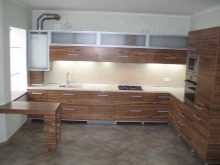
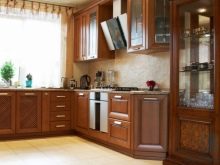

The disadvantages of veneered facades are found, as a rule, in products of low sample, which were made with a serious violation of the recommended technology. Such coatings peel off rather quickly from the base and soon begin to crack. Some owners of veneered furniture note: like natural wood, veneers can darken over time. However, in most cases, the hostesses are even to their taste, as it gives the product a noble, slightly aged look.
Nevertheless, if you want to protect your furniture from color changes, it is better to protect the facades from ultraviolet rays and update the varnished coating from time to time.
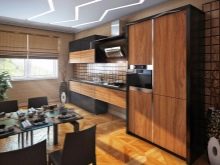
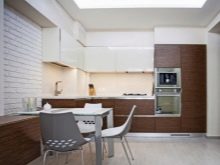
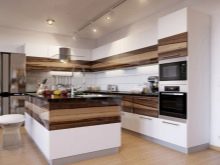
Selection of materials
For the manufacture of veneered coatings are used only the most expensive and beautiful types of wood:
- ash - characterized by increased strength, differs unobtrusive cool shade;
- alder - this tree is extremely resistant to deformation, as well as the adverse effects of moisture, makes a pleasant impression of a velvety surface;
- oak - one of the most noble and expressive materials of the highest strength and strength, such a coating will be durable and will not change its original appearance for many years;
- cherry - a strong and strong tree, which is distinguished by a pleasant reddish tint, over time it only becomes more saturated and deeper;
- nut - material of spectacular texture, presented in a rich tint palette.
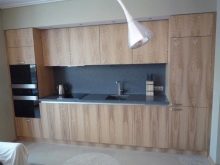
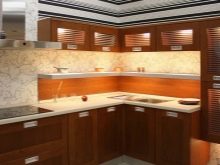

Thanks to the use of modern technologies, natural coatings have been repeatedly improved - they have become more uniform, durable and at the same time decorative. Thus, it turned out eco-veneer or fine-line, which in modern kitchens looks much brighter. Although its ideally smooth surface makes one doubt its natural origin, nevertheless it is the same ordinary wood, only before cutting it is painted and glued into blocks. Usually, an affordable and fairly soft poplar is used to produce such material. Such a coating is much cheaper than natural veneer, at the same time and inferior to it in density and durability.
However, this drawback cannot be called significant for the kitchen, since it completely covers the variety of colors and the ability to create the most unique textures on the veneer sheet.

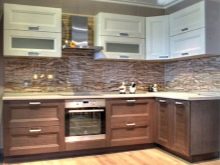
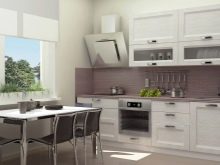
Color schemes
Any veneered kitchen set looks invariably elegant and refined, while the aesthetic features of the coating largely depend on the type of wood used to make it. Shades can be as follows:
- oak is presented in a rather diverse color palette - from dairy to black, an additional bonus will be its unique and deep texture, due to which the furniture looks expensive and stylish;
- alder is often used in the kitchen due to its light shades and velvety-looking structure;
- rosewood is the best choice for housewives who want the furniture in their kitchen to have a perfect woody pattern;
- Cherry has a dark wine tint that looks very impressive in any interior;
- ash is characterized by a color of cold light colors, therefore it is considered to be a universal solution for any kitchen;
- Zebrano is a very interesting option for lovers of exoticism, strips that perfectly fit into the most luxurious interiors are clearly visible in the structure of the tree;
- walnut has warm shades of grayish brown in a wide range of colors.
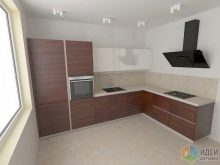
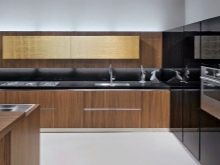

Design options
For furniture manufacturers, veneer has rightfully become a convenient and functional material. The fact is that the cut of natural wood is very thin, and therefore plastic and flexible. This opens up very broad opportunities for furniture design - veneer allows you to create a variety of shapes - from straight lines and right angles to the most ornate configurations (zigzags, waves, fashion asymmetry).
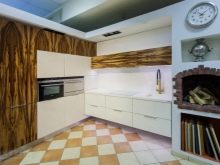
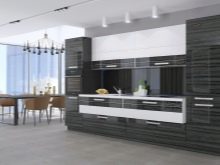
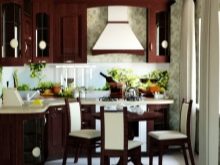
It is noteworthy that veneered surfaces are harmoniously combined with many materials, such as plastic, metal, glass and acrylic - interesting tandems with veneer allow you to realize any interior design ideas in the kitchen.
Veneer panels themselves look expensive and impressive, but in order to make the interior even more stylish and sophisticated, resort to decor. So, decorators often use the effect of aging veneered panels with special primers or supplement them with carved elements from natural wood. If desired, you can improve the kitchen facades, resorting to special enamels and paints.
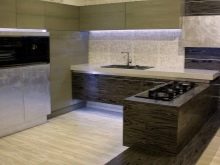
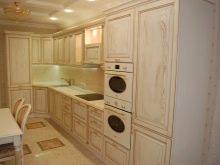
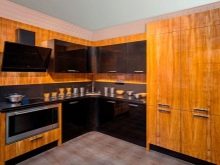
How to care?
Since veneer is primarily a tree, such a coating requires special treatment and special care. It must be cleaned daily - for this, use a soft cotton towel soaked in plain water and slightly wrung out. In case of severe pollution, you need to use a composition for cleaning furniture - you can purchase it at any hardware store. After processing, the surface is wiped dry with a cloth.
The use of abrasive powders to clean the coating is not allowed - this way you can scratch the facade.
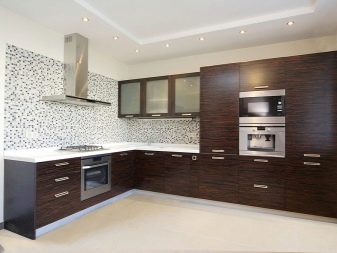
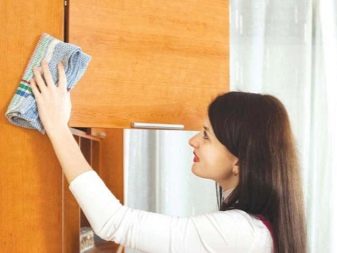
If you intend to polish the furniture, first you need to completely remove dust from it with a rag, then degrease it with any alcohol-containing means (for example, glass washing liquid), then apply polish and rub thoroughly in the direction of the wood fibers.
For in order for the veneer facade to maintain its aesthetic appearance for as long as possible, hot liquids must be avoidedflooding and severe mechanical damage (shock and contact with pointed objects).
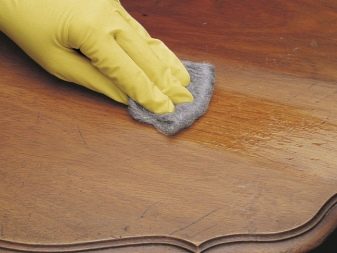
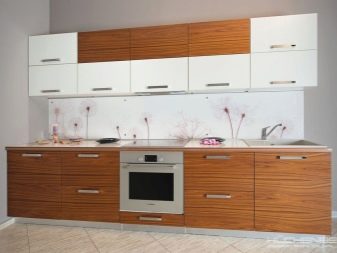
Beautiful examples
Veneers can be varied: light, dark, reddish and even striped.
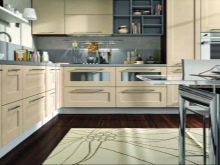
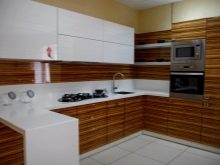
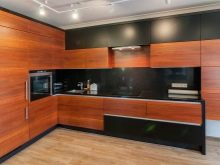
The one-piece veneered facade looks very impressive, but it is not very durable. If the budget allows you - make your choice in favor of panel or frame veneer. In this case, the panels are glued with veneer, and the edges are finished with plastic, metal or specially treated wood.
Of course, such an option will cost a lot, but, no doubt, it will protect the coating from water and drops of fat, which means that the facade will last you much longer.
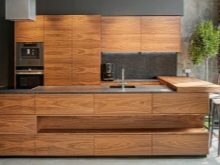
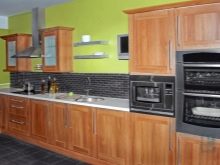
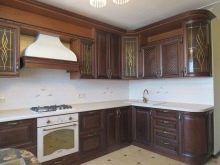
We have collected the most interesting examples of the use of veneered furniture in the kitchen. We hope that our photo selection will allow you to make a choice that will best suit your preferences and emphasize the interior design concept.
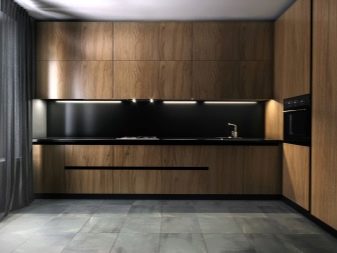
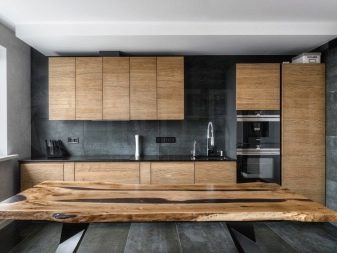
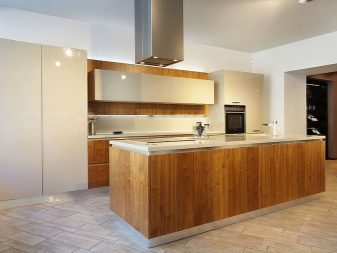
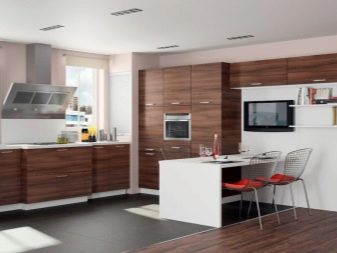
For the pros and cons of veneer facades for the kitchen, see the next video.
